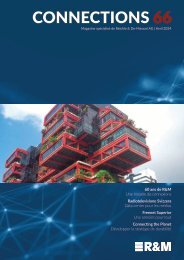CONNECTIONS_60-e
Specialist magazine CONNECTIONS no. 60
Specialist magazine CONNECTIONS no. 60
Create successful ePaper yourself
Turn your PDF publications into a flip-book with our unique Google optimized e-Paper software.
Fiber optics on the rise compared to traditional microwave radio<br />
050.7004 050.7005<br />
Small cell antenna<br />
challenge and, at the same time, a learning<br />
process for everyone involved. Business planners<br />
and technicians alike have been used to<br />
distinguishing between optical fiber for fixed<br />
network and for cellular phone network applications,<br />
and planning such capacities and<br />
costs separately.<br />
In addition, computing and storage capacities<br />
will have to be moved to the edge of the<br />
networks as 5G service expansion progresses<br />
(edge computing). In edge data centers,<br />
providers will in future make available the<br />
processing power and software applications<br />
required in particular for mission critical<br />
services (time-critical and data-sensitive services<br />
and applications). This is the only way<br />
to minimize transmission times for sensitive<br />
data on the path between the data center<br />
and subscribers.<br />
050.7003<br />
New approaches on the market<br />
The paradigm shift brought about by 5G<br />
is leading to new approaches to network<br />
design, network planning and infrastructure<br />
solutions. New types of service providers and<br />
variants of business models will be required<br />
to manage the shift and meet demand.<br />
Large companies will, for example, create<br />
private 5G networks for their company-specific<br />
communication and process needs and<br />
secure their own transmission bandwidths,<br />
i.e. 5G frequencies, for this purpose. This is<br />
already the case in some European countries<br />
where first wireless 5G enterprise or campus<br />
networks, as they are called, are already in<br />
test operation. First complex interoperability<br />
tests between the different system suppliers<br />
and the relevant industrial end user and that<br />
user’s specific IoT/5G applications are being<br />
carried out. With 5G, a whole new world of<br />
applications and individually designed solutions<br />
can be realized in the enterprise sector.<br />
Classic cellular phone network operators,<br />
who are now gradually upgrading their infrastructure<br />
and antenna sites with 5G technology,<br />
must, among other things, connect<br />
existing and many additional, new antenna<br />
sites with fiber optic networks. Due to time<br />
and capacity bottlenecks, these will no longer<br />
solely be proprietary optical fiber networks in<br />
the future. Increasingly, operators are using<br />
the capacities of existing FO networks for<br />
this purpose. They are relying on operators in<br />
the fixed network, FTTH and CATV sectors<br />
as well as on private data center connections<br />
and even FO networks of railway companies<br />
or local and regional utilities.<br />
New market players will discover their 5G<br />
opportunities, extend FO capacities and<br />
then rent them out for example to cellular<br />
phone network operators. They will become<br />
«neutral hosts». The tower companies (owners<br />
and operators of mobile communications<br />
or radio relay masts) are already in business<br />
with mobile communication suppliers. They<br />
will also take on additional new tasks and<br />
develop business models as the 5G rollout<br />
progresses.<br />
We would like to take a closer look at two<br />
models here.<br />
«Neutral host» model<br />
One of the new concepts, which is already well<br />
established particularly in the US and the UK,<br />
is that of the neutral host. The host operates a<br />
communication network with its own optical<br />
core, edge and remote access infrastructures.<br />
Mobile network operators rent optical<br />
network capacity or even complete services<br />
from these service providers on certain<br />
routes. In this way, they save on investments<br />
in infrastructure and system hardware as well<br />
as on personnel and costs for operation and<br />
maintenance. They thus gain time and budget<br />
for the development and marketing of new<br />
end-to-end applications, the provision of<br />
new software packages and media content.<br />
Mobile network operators want to focus in<br />
particular on market development for new<br />
5G applications, especially in the lucrative,<br />
professional customer environment (5G<br />
Wireless Enterprise) and on media and direct<br />
interaction with their end users.<br />
This concept ultimately challenges traditional<br />
network construction and operation by<br />
telecom carriers. Instead, a third party builds,<br />
04|2021–<strong>60</strong> <strong>CONNECTIONS</strong> | 5

















